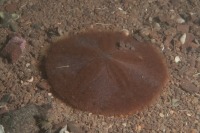
(Photo: Claire Goodwin)
Common Sand Dollar
Echinarachnius parma
Flattened circular body up to ten centimetres in diameter. The skeleton (test) of a sand dollar is white or pale yellow: you sometimes find these on beaches. But, when living, many tiny spines perforate the test. These give it a velvety appearance and a brown or purple colour. The test has a pattern like a five-petaled flower. Scientists think the low profile of sand dollars is an adaptation to reduce the drag from ocean currents. This allows them to live in high current areas on unstable sand.
Authority
Lamarck, 1816
Classification Details
Phylum: Echinodermata (echinoderms); Class: Echinoidea (sea urchins, sand dollars, and heart urchins).
Habitat
Found from Labrador to Maryland on the east coast of Canada and America. Also present from Alaska to Puget Sound on the west coast. Occur from the intertidal down to depths of over 1600 m. They live on sandy seabeds either on the surface or buried into the sediment. They can reach densities of hundreds per square metre.
Diet
Feed on small (<230 µm) particles from the sediment such as diatoms. They use structures called podia on their lower surface to collect particles. They trap the particles in mucus on the ends of the podia. They then pass them into their mouths via food grooves.
Reproduction
Sexes are separate. Adults release eggs and sperm and these are externally. Release is triggered by water temperature. After a planktonic larval phase, the larvae settle to the seabed when they reach around 0.4 mm in length. Chemical cues from adult sand dollars help them to find the right areas to settle in. Individuals can live for up to eight years.
Fun Facts
Their latin name derives from the latin parma, an oval or round shield used by Roman troops.
Sand dollars are keystone species. Scientists think that they are the second most important factor, after major storms, in reworking surface sediments.
Olaf Ellers and Malcolm Telford undertook their studies on sand dollar feeding (see references) at the Huntsman Marine Science Centre in the 1980s.
References
Ables J (2000) Echinarachnius parma. Animal Diversity Web. https://animaldiversity.org/accounts/Echinarachnius_parma/ Accessed online June 19, 2020. Ellers O and Telford M (1984) Collection of food by oral surface podia in the sand dollar, Echinarachnius parma (Lamarck). Biological Bulletin 166, 574–582. Kennedy J (2020) Sand Dollar Facts. ThoughtCo, http://thoughtco.com/sand-dollar-profile-2291807 Accessed online February 19, 2020. Kroh A and Mooi R (2020) World Echinoidea Database. Echinarachnius parma (Lamarck, 1816). Accessed through: World Register of Marine Species at: http://www.marinespecies.org/aphia.php?p=taxdetails&id=158062 Accessed online June 19 2020. Steimle FW (1989) Population dynamics, growth, and production estimates for the sand dollar Echinarachnius parma. Fishery Bulletin 88, 179–189.

